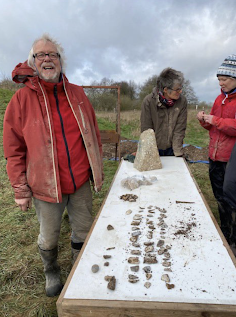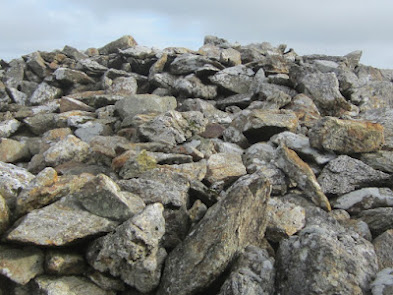Just joking? No, this is quite serious.......
And this sort of thing is a disgrace -- a result of slapdash research and interpretative inflation on
the part of archaeologists and sloppy and uncritical reporting by journalists.
It happens all the time..... with PR hype trumping scientific reliability.
As we all know, we live in an age of pseudo-science and myth-making, in which gullible people are all too often fooled by authority figures into believing all sorts of nonsense:
https://brian-mountainman.blogspot.com/2011/04/on-pseudoscience.html
You have heard about Occam's Razor and Hitchens's Razor -- both rather useful in teaching us about the reliability -- or otherwise -- of claims that are made by scientists about their own research. Well, on giving some thought to the matter, I hereby pronounce
My Razor:
Any claim made in a press release or in the media may be ignored unless the original research upon which it is based is freely (ie without limitation) accessible to all who may wish to knowledgeably scrutinize it.
This becomes essential in view of the increasingly outrageous claims made in press releases and in the media by individual researchers or research teams (across all disciplines) who seek "maximum impact." There should be a standard expectation that any author who creates or approves any media coverage should be held personally responsible for the placing of his/her research fully in the public domain. Research must not be hidden behind paywalls or otherwise restricted to a privileged group of readers. As mentioned in my last post, all too often nowadays, "open access" journals are often not really open at all -- they are closed to all but a select few.
https://brian-mountainman.blogspot.com/2023/03/the-bluestone-papers-some-available.html
There are nowadays no real obstacles to full open access -- it is a simple matter for an author to make his/her research available to anybody who has a computer by simply uploading a PDF of an article onto platforms such as Researchgate and Academia. It takes less than five minutes. A URL is immediately available for the article, which can then be shared as a hyperlink on social media or via websites or Email messages.
In the good old days researchers were much more circumspect in their announcements of research results, and journalists were more cautious in their reporting. Nowadays IMPACT is everything, and academics and university press offices have -- sometimes against their better judgment -- been sucked into a system in which truth has dropped down the list of priorities. So my Razor is in essence something that is required as a result of a modern combination of circumstances. Electric razor rather than the original cut-throat or the disposable Gillette! I would like to see universities, departments and learned societies signing up for a new code of practice with my statement at its core; if they don't, I can see an inexorable slide in standards, to the point where nobody trusts anything that comes out of academia any more. That would be a tragedy, since academia is of course mostly populated by good people and experts who know what they are talking about. But their reputations are being placed at risk by the behaviour of the few. If they personally and corporately sign up to what I am suggesting, at no cost to themselves, maybe the situation can be rescued........
Now it may be argued that research results have never actually been freely available to all, but have always been restricted to an academic elite. When I was a student, I was able to access most articles that I needed to consult through visits to public libraries, since they almost always took printed copies of the main journals; and there was no charge for access. In my days as a lecturer, I belonged to a few learned societies, and their journals came in the post as one of the perks of membership. But I was of course a member of a privileged group. Now library access has gradually been whittled away with library closures, the excessive cost of journal subscriptions, and the proliferation of new journals. There are today literally thousands of outlets for research publication, but ironically that has made research results much more difficult to get at for the interested and informed layman.
=====================
Occam's Razor:
This is known as the scientific principle of parsimony. This is a good definition: "Of two equivalent theories or explanations, all other things being equal, the simpler one is to be preferred".
As far as the science of landscape is concerned, our principle is this: If a past phenomenon can be understood as the result of a process now acting in time and space, do not invent or invoke an extinct or unknown or supernatural cause as its explanation. By the same token, if a landscape can be understood by reference to known physical processes, even if they have varied through space and time because of climate change or crustal movements, do not bring in "invented" processes which are unverifiable through observation.
Stephen Gould (1987): “We should try to explain the past by causes now in operation without inventing extra, fancy, or unknown causes, however plausible in logic, if available processes suffice.”
https://brian-mountainman.blogspot.com/2011/01/uniformitarianism-and-occams-razor.htmlhttps://brian-mountainman.blogspot.com/2021/09/bluestone-museum-new-acquisition.html
Hitchens's Razor:
An epistemological razor asserting that the burden of proof regarding the truthfulness of a claim lies with the one who makes the claim; if this burden is not met, the claim is unfounded and its opponents need not argue further in order to dismiss it. It is named, echoing Occam's razor, for the journalist and writer Christopher Hitchens, who, in a 2003 Slate article, formulated it thus: "What can be asserted without evidence can be dismissed without evidence."
https://brian-mountainman.blogspot.com/2017/05/hitchenss-razor-and-century-of.html
See also:
ECREEThe Sagan standard is a neologism abbreviating the aphorism that "extraordinary claims require extraordinary evidence" (ECREE). It is named after science communicator Carl Sagan who used the exact phrase on his television program Cosmos. The Sagan standard, according to Tressoldi (2011), "is at the heart of the scientific method, and a model for critical thinking, rational thought and skepticism everywhere". ECREE is related to Occam's razor in the sense that according to such a heuristic, simpler explanations are preferred to more complicated ones. Only in situations where extraordinary evidence exists would an extraordinary claim be the simplest explanation.
Brandolini's Law
From Wikipedia, the free encyclopedia
Brandolini's law, also known as the bullshit asymmetry principle, is an internet adage that emphasizes the effort of debunking misinformation, in comparison to the relative ease of creating it in the first place. It states that "The amount of energy needed to refute bullshit is an order of magnitude bigger than that needed to produce it."
=====================
From Wikipedia:
In
philosophy, a razor is a
principle or
rule of thumb that allows one to eliminate ("shave off") unlikely explanations for a phenomenon, or avoid unnecessary actions.
Razors include:
Alder's razor (also known as Newton's Flaming Laser Sword): If something cannot be settled by experiment or observation, then it is not worthy of debate.
Einstein's razor: "The supreme goal of all theory is to make the irreducible basic elements as simple and as few as possible without having to surrender the adequate representation of a single datum of experience."Often paraphrased as "make things as simple as possible, but no simpler."
Grice's razor (also known as Giume's razor): As a principle of
parsimony, conversational
implications are to be preferred over semantic context for
linguistic explanations.
Hanlon's razor: Never attribute to malice that which can be adequately explained by stupidity.
Hitchens's razor: That which can be asserted without evidence can be dismissed without evidence.
Hume's guillotine: What ought to be cannot be deduced from what is. "If the cause, assigned for any effect, be not sufficient to produce it, we must either reject that cause, or add to it such qualities as will give it a just proportion to the effect."
Occam's razor: Simpler explanations are more likely to be correct; avoid unnecessary or improbable assumptions.
Popper's falsifiability principle: For a theory to be considered scientific, it must be falsifiable.
Russell's teapot: Is an analogy, formulated by the philosopher Bertrand Russell (1872–1970), to illustrate that the philosophic burden of proof lies upon a person making empirically unfalsifiable claims, rather than shifting the burden of disproof to others. He wrote that if he were to assert, without offering proof, that a teapot, too small to be seen by telescopes, orbits the Sun somewhere in space between the Earth and Mars, he could not expect anyone to believe him solely because his assertion could not be proven wrong.
Sagan standard: Extraordinary claims require extraordinary evidence.
So is my Razor really a razor in the sense of the others mentioned above? Well, yes, it is, because it is all about the "shaving off" of things that are not really necessary, and the elimination of worthless or wasteful activities.






























